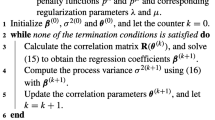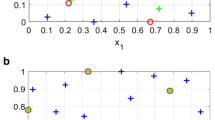Abstract
In practical engineering and industry fields, complicated and correlated problems are often descripted by implicit expression. The Kriging model is one of the popular spatial interpolation models to surrogate the numerical relationship between input and output variables. But the efficiency of the Kriging surrogate model is limited when confronting with large databases. The subset simulation is a promising selection method to provide more important and typical samples. By the subset simulation, the Kriging surrogate model can significantly reduce the computational cost in regression, since much fewer samples are required. Besides, more reliable prediction results can be obtained because of the emphasis on the samples that are more representative in the Kriging fitting process. Examples are performed to confirm the properties of the Kriging surrogate model based on the subset simulation.










Similar content being viewed by others
References
Au SK, Beck JL (2001) Estimation of small failure probabilities in high dimensions by subset simulation. Probab Eng Mech 16(4):263–277
Baar JHSD, Dwight RP, Bijl H (2013) Speeding up Kriging through fast estimation of the hyperparameters in the frequency-domain. Pergamon Press Inc, Oxford
Booker AJ, Dennis JE, Frank PD et al (1999) A rigorous framework for optimization of expensive functions by surrogates. Struct Optim 17(1):1–13
Bourinet JM, Deheeger F, Lemaire M (2011) Assessing small failure probabilities by combined subset simulation and support vector machines. Struct Saf 33(6):343–353
Chiachio M, Beck JL, Chiachio J et al (2014) Approximate Bayesian computation by subset simulation. Siam J Sci Comput 36(3):A1339–A1338
Chilès JP, Delfiner P (2012) Geostatistics: modeling spatial uncertainty[M]
Ching J, Au SK, Beck JL (2005) Reliability estimation for dynamical systems subject to stochastic excitation using subset simulation with splitting. Comput Methods Appl Mech Eng 194(12–16):1557–1579
Cousin A, Maatouk H, Rullière D (2016) Kriging of financial term-structures. Eur J Oper Res 255(2):631–648
Cressie N, Johannesson G (2008) Fixed rank kriging for very large spatial data sets. J R Stat Soc 70(1):209–226
Dubreuil S, Bartoli N, Gogu C et al (2018) Extreme value oriented random field discretization based on an hybrid polynomial chaos expansion—Kriging approach. Comput Methods Appl Mech Eng 332:540–571
Fritz J, Neuweiler I, Nowak W (2009) Application of FFT-based algorithms for large-scale universal Kriging problems. Math Geosci 41(5):509–533
Fuentes M (2007) Approximate likelihood for large irregularly spaced spatial data. J Am Stat Assoc 102(477):321–331
Joseph VR (2006) Limit Kriging. Technometrics 48(4):458–466
Katafygiotis LS, Cheung SH (2007) Application of spherical subset simulation method and auxiliary domain method on a benchmark reliability study. Struct Saf 29(3):194–207
Kleijnenab JPC (2005) Robustness of Kriging when interpolating in random simulation with heterogeneous variances: some experiments. Eur J Oper Res 165(3):826–834
Lelièvre N, Beaurepaire P, Mattrand C et al (2018) AK-MCSi: a Kriging-based method to deal with small failure probabilities and time-consuming models. Struct Saf 73:1–11
Li HS, Au SK (2010) Design optimization using subset simulation algorithm. Struct Saf 32(6):384–392
Li R, Sudjianto A (2005) Analysis of computer experiments using penalized likelihood in Gaussian Kriging models. Technometrics 47(2):111–120
Li YF, Ng SH, Xie M et al (2010) A systematic comparison of metamodeling techniques for simulation optimization in decision support systems. Appl Soft Comput 10(4):1257–1273
Li DQ, Xiao T, Cao ZJ et al (2016) Efficient and consistent reliability analysis of soil slope stability using both limit equilibrium analysis and finite element analysis. Appl Math Model 40(9–10):5216–5229
Linkletter C, Bingham D, Hengartner N et al (2006) Variable selection for Gaussian process models in computer experiments. Technometrics 48(4):478–490
Lophaven SN (2002) DACEA Matlab Kriging toolbox, version 2.0
Matheron G (1963) Principles of geostatistics. Econ Geol 58(8):1246–1266
Papadopoulos V, Giovanis DG, Lagaros ND et al (2012) Accelerated subset simulation with neural networks for reliability analysis. Comput Methods Appl Mech Eng 223–224(2):70–80
Pellissetti MF, Schuëller GI, Pradlwarter HJ et al (2006) Reliability analysis of spacecraft structures under static and dynamic loading. Comput Struct 84(21):1313–1325
Pistone G, Vicario G (2010) Comparing and generating latin hypercube designs in Kriging models. Asta Adv Stat Anal 94(4):353–366
Rennen G (2009) Subset selection from large datasets for Kriging modeling. Struct Multidiscip Optim 38(6):545–569
Roshan V, Ying H, Sudjianto A (2008) Blind Kriging: a new method for developing metamodels. J Mech Des 130(3):350–353
Santoso AM, Phoon KK, Quek ST (2011) Modified metropolis-Hastings algorithm with reduced chain correlation for efficient subset simulation. Probab Eng Mech 26(2):331–341
Sen O, Gaul NJ, Choi KK et al (2017) Evaluation of kriging based surrogate models constructed from mesoscale computations of shock interaction with particles. J Comput Phys 336:235–260
Siem AYD, Hertog DD (2007) Kriging models that are robust with respect to simulation errors. Ssrn Electron J 2007–68:1–28
Simpson TW, Poplinski JD, Koch PN et al (2001) Metamodels for computer-based engineering design: survey and recommendations. Eng Comput 17(2):129–150
Sunny MR, Mulani SB, Sanyal S, Kapania R (2016) An artificial neural network residual Kriging based surrogate model for curvilinearly stiffened panel optimization. Adv Comput Des 1:235
Yin J, Ng SH, Ng KM (2011) Kriging metamodel with modified nugget-effect: the heteroscedastic variance case. Comput Ind Eng 61(3):760–777
Zio E, Pedroni N (2012) Monte Carlo simulation-based sensitivity analysis of the model of a thermal–hydraulic passive system. Reliab Eng Syst Saf 107(4):90–106
Zuev KM, Katafygiotis LS (2011) Modified Metropolis-Hastings algorithm with delayed rejection. Probab Eng Mech 26(3):405–412
Zuev KM, Beck JL, Au SK et al (2012) Bayesian post-processor and other enhancements of subset simulation for estimating failure probabilities in high dimensions. Comput Struct 92–93(3):283–296
Author information
Authors and Affiliations
Corresponding author
Additional information
Communicated by Antonio José Silva Neto.
Publisher's Note
Springer Nature remains neutral with regard to jurisdictional claims in published maps and institutional affiliations.
Rights and permissions
About this article
Cite this article
Chu, L., Shi, J., Souza de Cursi, E. et al. Efficiency improvement of Kriging surrogate model by subset simulation in implicit expression problems. Comp. Appl. Math. 39, 119 (2020). https://doi.org/10.1007/s40314-020-01147-1
Received:
Revised:
Accepted:
Published:
DOI: https://doi.org/10.1007/s40314-020-01147-1




